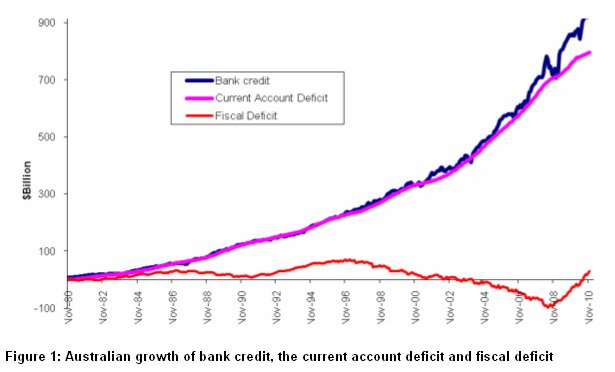I discovered Leigh Harkness’s web site a few months ago while doing some research on foreign trade. His site so intrigued me that I contacted him to see if he would be interested in doing a series of guest posts about his research and experience in his little understood area of economics. Leigh accepted my invitation.
Leigh has previously worked at the Australian Treasury and also wrote a submission to the latest enquiry into banking competition. He has some very interesting theories so I am sure his posts will stir some interesting discussions. Without further ado here is his first post titled “Bank credit and the current account deficit”
Some time ago, I was the economist for a small South Pacific Island country.
Until 1974, that country did not have a bank. Even so, the country issued its own currency. When foreign currency came in, the government would exchange that money for domestic currency and add the foreign money to the country’s foreign reserves. When people spent money on imports, the government converted their domestic currency back to foreign currency to pay for the imports. In that way the country always had sufficient foreign reserves to pay for its imports.
When the country established a bank, it started lending money. That lending created additional money that did not contribute to foreign reserves. Yet, when that money was spent on imports, it still needed to be converted into foreign currency. Therefore, increased bank lending depleted the country’s foreign reserves.
To ensure that there were adequate foreign reserves to meet requirements, the government advised the bank to regulate its lending according to the level of foreign reserves. If there were plenty of foreign reserves, it could lend without restraint. But if foreign reserves were low, it had to slow down or stop lending.
That system worked well. It limited the growth of bank credit to the growth of national savings. In the year following the introduction of these guidelines, a hurricane destroyed most of the economy’s export industries. Yet the country did not experience any balance of payments problems. The bank managed its lending according to the level of national savings.
I later joined the Australian Treasury. Australia had a growing current account deficit and I investigated whether bank credit was responsible for that deficit, as it had been in that South Pacific island. Figure 1 presents an updated graph of the evidence that I found.
There is evidence of a similar relationship between bank credit and the current account deficit for New Zealand, America and the Philippines,
Entitlements and obligations
In our monetary system, currency is a record, or account, of current entitlements. Counterbalancing that entitlement should be accounts of current obligations.
Bonds are records of future entitlements. Counterbalancing those future entitlements are obligations to pay in the future. Those obligations are tied to the people that issued the bonds. Without that obligation, the bonds would be worthless.
The obligation for currency is not tied to a particular person; it is linked to the obligations of the whole monetary system. If currency is created without a corresponding current obligation, it affects all currency and the whole monetary system.
Currency is used as a medium of exchange to buy and sell products. Bonds may be exchanged for currency and, occasionally, they may be accepted in exchange for products. But whoever accepts bonds in exchange for products recognizes that they cannot be used to pay wages and suppliers. The bonds must be sold in exchange for currency before the proceeds of the products sold are available to be spent. Bonds are not money.
If currency is issued against future obligations, it creates additional current entitlements but there are not any additional current obligations to supply the products demanded. The additional money will cause the economy to buy more than it has produced, unless there are offsetting national savings. That is, without offsetting savings, it will cause current account deficits.
Bank lending creates current entitlements against future obligations. The deregulation of the banking system has enabled banks to increase their lending. That has increased the amount of current entitlements issued against future obligations. It is this growth in bank credit has led to a rise in current account deficits.
Banks’ books may appear balanced with debits equal to credits. However, in terms of timing, the entitlements that they grant and the corresponding obligations are not synchronized. Imports are required to satisfy the additional demand for the time between when the current entitlements were issued and when the loan was repaid.
As total bank lending has been rising, it means that new loans have been issued faster than old debt has been repaid. Therefore, current account deficits have persisted and been equal to the growth in total bank credit, less any national savings.
National savings are not superannuation or deposits in bank accounts. They are the nation’s income from the sale of exports that has not been spent on imports. Essentially, they are foreign investments and the foreign reserves of the banking system.
In the days of fixed exchange rates, nations built up foreign reserves and saved. But deregulation of the banking system caused those savings to decline. The currency had to be floated to protect those reserves. When a currency is floated, the whole financial system is required to balance international receipts and payments. The monetary system no longer draws upon, nor contributes, to national savings.
Therefore, unless private international savings are greater than the growth of bank credit (as in Japan), countries with floating exchange rates will experience current account deficits equal to the growth of bank credit.
